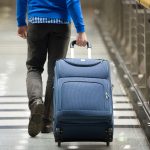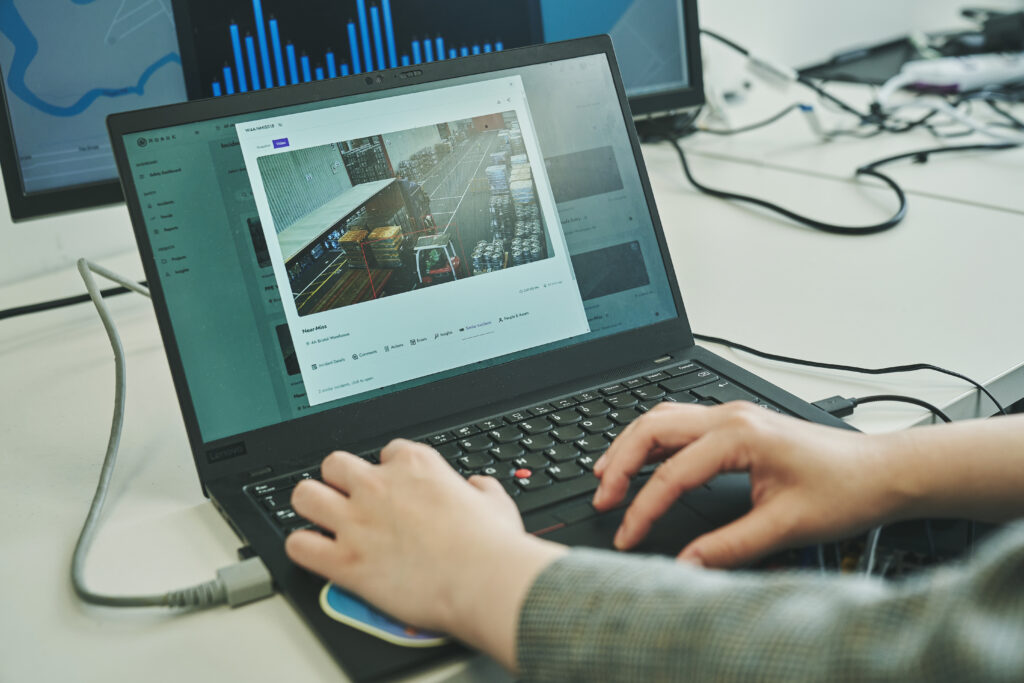
Meet the Innovator using AI to monitor site safety

Mistakes caused by lapses in concentration or a rush to meet deadlines affect most workers at some time, but the consequences can be more severe for those driving machinery or stood near moving vehicles.
In an effort to reduce the chance of injury and encourage better behaviour in a warehouse or around a port, entrepreneur Hao Zheng and RoboK ─ the company she co-founded – have developed a software solution to spot safety or procedural breaches, and highlight issues of concern.
Known as SiteLens, the system uses artificial intelligence to track the movement of people and plant to monitor whether both are operating and interacting safely in highly dynamic industrial workplaces such as warehouses. It can even detect if workers are not wearing personal protective equipment such as hard hats.
The tool has also been used to determine whether a level crossing of a railway line is being used correctly by members of the public.

In recent years, RoboK has been supported by Connected Places Catapult which has welcomed the Cambridge-based company on to several of its accelerator and investment programmes.
“People don't go to work to get hurt, but they risk doing so if it’s busy, things are chaotic or they have been delayed,” says Hao Zheng. “All of a sudden people start to rush, spaces get crowded and it becomes difficult to follow the rules of having vehicles and people completely segregated.
“We study what people do every day, and can uncover a lot of insight that can be used to evaluate the effectiveness of how a space is designed. It can lead to really powerful conversations.”
Companies who make efforts to reduce the number of near misses at their sites could potentially avoid something more serious, Hao adds. Following a trial of the system for the Bristol Port Company the number of issues of concern dropped by 90% within three months.
“This is not about pointing fingers, it's about identifying risks and making people aware of them,” she adds.
Spotting problems early
Use of artificial intelligence to monitor safety also helps to make it easier for operations staff to spot breaches of protocol, she adds. “People find that watching a series of CCTV cameras can be repetitive and requires a high level of cognitive load.
“Artificial intelligence, on the other hand, offers great benefits when it’s used to automate tasks that are either dull, dirty or dangerous,” she adds.
SiteLens is trained to understand people’s movements and creates computer visualisations of the data. Algorithms study the relationship between different moving objects to give customers looking at a dashboard hazard information.
Earlier this summer RoboK announced it had raised $2.1 million in funding from investors to help it expand its team and deliver a more rounded product, taking the total investment raised to $4 million since the company was founded five years ago.
Enjoying a rapid ascent
RoboK is a start-up company spun out from the University of Cambridge, has a staff of 10 and is expanding. The final letter of its name is derived from King’s College, where Hao was a student. Born in China, she grew up in Australia and won a scholarship to study statistics and economics at a prestigious university in Melbourne.
Hao came to Cambridge in 2016 and completed a Masters in economics. Alongside other students, they won a college competition that led to investment and Hao went to work for computer chip designer Arm. She then co-founded RoboK and became its chief executive in 2019.
Initially the company was focused on creating safety systems for autonomous cars, using computer vision to turn 2D information into three dimensions.

But uncertainty with future prospects during the pandemic led Hao to take stock of its business direction.
“Early stage start-up companies should be prepared to pivot to something new when things don’t work out,” she reflects. “We looked at where else we could apply our technology and stumbled upon an opportunity.”
Instead of using cameras on vehicles to monitor safety, they decided to make use of existing surveillance cameras attached to fixed points within large sites. “We were already creating technology capable of turning videos into information, so pivoted into working with fixed cameras.
“We learned that people rarely watch cameras proactively; only when something has happened. People would use CCTV to investigate something and spend hours trying to find out which camera covered it.”
The company settled upon maritime as a first use case for SiteLens. “Ninety-five percent of everything that comes into the UK is transported by sea, so there is a huge opportunity there.
“Our main focus is on how we help people working in industry. Safety problems tend only to be flagged when someone reports it, so the computer vision software is designed to automate that process and provide details of near misses to help prevent incidents.”
Transferring to other sectors
RoboK has since expanded into other sectors such as roads; and has developed an application that can detect stationary vehicles in need of recovery in roadworks sites.
The company also rolled out the system for use at a level crossing on a railway near Cardiff to monitor the manner in which around 800 people used it every day en-route to work or school; identifying if people stopped on the tracks. As a result of the insight, the design of the crossing was changed as it was deemed not to be ‘intuitive’ enough for people to use safely.
The company’s first involvement with Connected Places Catapult was through the Milton Keynes 5G Accelerator programme, which gave it an opportunity to carry out a proof-of-concept trial of its technology on the MK Dons football stadium to monitor crowd queuing.
Last year it joined a consortium looking at the use of intelligent drones in ports and highways through the ‘InDePTH’ technology project. This was followed by gaining a place on the Freight Innovation Fund Accelerator, where the company secured £133,000 to trial its system at the Port of Tyne. Hao has since been invited to sit on the Freight Innovation Cluster Advisory Board convened by the Catapult to help shape future thinking in line with the Government’s freight strategy.
The company was also one of 10 innovators selected by National Highways and Connected Places Catapult this spring to develop ideas to reduce the impact of roadworks on motorists. In addition, RoboK was named as one of 67 firms that received funding through the Transport Research and Innovation Grants programme, delivered by the Catapult on behalf of the Department for Transport.
Focusing on the positives
Hao describes being an innovator as if she is “on a rollercoaster”; noting that “happiness is a lot less enduring than pain and disappointment” of challenges or setbacks. “Despite this, I am naturally curious and optimistic and find myself getting drawn towards building solutions to delight customers,” she adds.
“Being involved with a start-up is high risk, but that risk is reduced by working very closely with industry experts and potential customers.”
She also says that trials of products such as SiteLens are helping to give artificial intelligence a better name, in the face of ongoing concerns. “We need to communicate clearly what the data is being used for, and that we listen to customers about what matters to them. We must also make sure we don't give people the feeling that Big Brother is watching them.”
Interested in hearing more from RoboK's Hao Zheng? She recently gave her views on how procurement processes can be made more innovation-friendly on the Connected Places Podcast.





